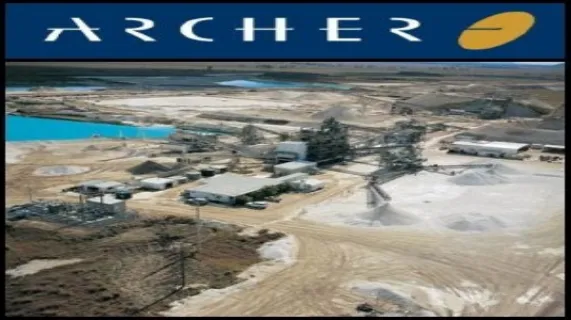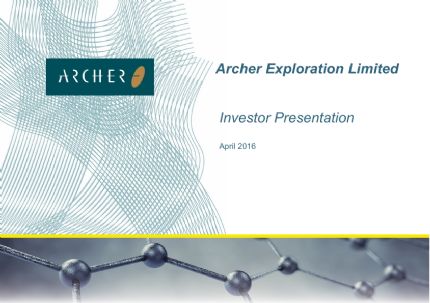
Archer Exploration Limited (ASX:AXE) Confirmed Continuity of Sugarloaf Graphite Deposit
Perth, Sep 22, 2011 AEST (ABN Newswire) - As previously announced Archer Exploration Limited ( ASX:AXE) completed a series of drill holes in 2008 testing anomalous copper-gold results grading >0.1g/t Au recorded in close-spaced rock chip samples taken at Sugarloaf. Archer recovered samples from two of those drill holes, CHRC011 and CHRC012, to assay for carbon. These results have now been returned and show that the Sugarloaf graphite deposit is continuous over a strike length of at least 2.2km.
ASX:AXE) completed a series of drill holes in 2008 testing anomalous copper-gold results grading >0.1g/t Au recorded in close-spaced rock chip samples taken at Sugarloaf. Archer recovered samples from two of those drill holes, CHRC011 and CHRC012, to assay for carbon. These results have now been returned and show that the Sugarloaf graphite deposit is continuous over a strike length of at least 2.2km.
The importance of these recent assays is that they confirm the northern strike continuity of the 2011 drilling (SLRC001 to SLRC004). Additionally and importantly the new drill intervals are close to intrusive felsic rocks that have potential to increase the graphite flake size in adjacent rocks. Petrology has commenced to confirm if larger flake graphite has been developed adjacent to the felsic intrusive bodies.
Updated graphite drill intervals for Sugarloaf
CHRC011
Anomalous graphite occurs throughout the drill hole including two wide intersections of higher grade graphite from 28-36m and from 36-76m down hole.
In reporting carbon assays for graphite it is important to ensure that assays are also conducted to detect other carbon-bearing minerals which if present, may give a false impression as to the grade of the graphite.
From Table 1 (see link at the bottom of the release) it is clear that there is little to no carbonate present in the graphitic ore.
Silica is the dominant gangue mineral present with subordinate chlorite, biotite and trace sulphur contributed by weathered sulphides.
When intervals containing only the highest grades of carbon are considered, it can be seen from the chemistry that other elements comprise very small percentages of the rock, silica will be the dominant material.
CHRC012
The interval 75m to 80m reports 22.56% carbon with one interval (76 to 77m) reporting the highest carbon assay to date at 26.4% carbon.
As with hole CHRC011 there is little to no carbonate present in the graphitic intervals. CHRC012 intersected two very thick graphite horizons from 0-44m and from 50-86m down hole.
The next steps
Samples collected from several of the graphite intervals have been submitted for detailed petrological examination specifically to determine the flake size and morphology of the graphite.
Drilling of the Campoona South and Grid 2 graphite deposits is scheduled to begin late this month.
About Graphite
Graphite and diamonds are the only two naturally formed polymers of carbon. Graphite is an excellent conductor of heat and electricity and has the highest natural strength and stiffness of any material. It maintains its strength and stability to temperatures in excess of 3,600 degree Celsius and is very resistant to chemical attack. At the same time it is one of the lightest of all reinforcing agents and has high natural lubricity.
GRAPHITE USES
Traditional Uses for Graphite
Traditional demand for graphite is largely tied to the steel industry where it is used as a liner for ladles and crucibles, as a component in bricks which line furnaces and as an agent to increase the carbon content of steel. In the automotive industry it is used in brake linings, gaskets and clutch materials. Graphite also has a myriad of other uses in batteries, lubricants, fire retardants, and reinforcements in plastics.
Industrial demand for graphite has been growing at about 5 per cent per annum for most of this decade due to the ongoing industrialization in China, India and other emerging economies.
Rapidly Growing Demand for Graphite from "Green Initiatives"
Graphite demand is increasing in response to a number of green energy initiatives including lithium-ion batteries, fuel cells, solar energy, semi-conductors, and nuclear energy. Many of these applications have the potential to consume more graphite that all current uses combined.
The market for graphite exceeds one million tonnes per year with some 600,000 tonnes produced as amorphous graphite powder and 400,000 tonnes of various sized crystalline flake graphite.
China produces around 80 per of the world's graphite supply. Approximately 70% of Chinese production is graphite powder termed amorphous graphite. Chinese graphite is declining in quality and costs are increasing due to the effects of high grading and to tightening labor and environmental standards. The majority of Chinese graphite mines are small and many are seasonal. Easily mined surface oxide deposits are being depleted and mining is moving into deeper and higher cost deposits. China now has a 20% export duty on graphite, as well as a 17% VAT, and has instituted an export licensing system to ensure supply to its domestic economy including its burgeoning steel industry which internally consumes a great deal of graphite. These measures are creating supply concerns for the rest of the world.
The demand for graphite is expected to increase as the world seeks newer and better energy storage solutions to provide clean portable energy, alternative fuel for the automotive industry (the emergence of hybrid electric vehicles) and energy storage solutions for green energy initiatives such as solar energy.
Graphite is in strong demand for use lithium-ion batteries. Lithium-ion batteries are smaller, lighter and more powerful than traditional batteries. They have no memory effect and a very low rate of discharge when not in use. As a result, most portable consumer devices such as laptops, mobile phones, MP3 players and digital cameras use lithium-ion batteries. These batteries are now also being used in power tools.
Lithium-ion batteries are now being used in hybrid electric vehicles ("HEV"), plug in electric vehicles ("PEV") and all electric vehicles ("EV") where the batteries are large and the potential demand for graphite is huge. There is twenty times more graphite that lithium in lithium-ion batteries.
While batteries store electrical energy for subsequent use, fuel cells also generate electricity through chemical reactions and therefore need to be periodically "refueled". Fuel cells can be used in both stationary and mobile applications. Fuel cells use substantially more graphite than lithium ion batteries. Fuel cells have no moving parts, are long lasting, low maintenance, quiet and reliable and produce little or no waste products.
Graphite use is also expected to rise sharply due to its growing use in Pebble Bed Nuclear Reactors ("PBNR"). These reactors are small, modular nuclear reactors. The fuel is uranium imbedded in graphite balls the size of tennis balls. These reactors have a number of advantages over large traditional reactors namely:
Lower capital and operating costs. They use inert gases rather than water as coolants. Therefore, they do not need the large, complex water cooling systems of conventional reactors and the inert gases do not dissolve and carry contaminants. These reactors cool naturally when shut down. The reactors operate at higher temperatures leading to more efficient use of the fuel and they can directly heat fluids for low pressure gas turbines.
The first prototype is operating in China and the country has firm plans to build 30 by 2020. China ultimately plans to build up to 300 Gigawatts of capacity and PBNRs are a major part of the strategy.
Small, modular reactors are also very attractive to small population centers or large and especially remote industrial applications. Companies such as Hitachi are currently working on turn-key solutions. Researchers at West Virginia University estimate that 500 new 100GW pebble reactors will be installed in the US by 2020 with an estimated graphite requirement of 400,000 tonnes. This alone is equal to the world's current annual production of flake graphite without taking into account pebble reactor demand from the rest of the world, growing industrial demand and growing demand from other applications such as lithium-ion batteries. It is estimated that each pebble reactor will require 300 tonnes of graphite at start up and 60-100 tonnes per year to operate.
Demand Trends
Refractories remain the largest end use for the graphite market (35%), where flake and amorphous grades are used in various applications. Flake graphite provides good oxidation and corrosion resistance, while improving the structural strength of castable and shaped refractories. Amorphous graphite is applied where a flexible and deformable product is required. The short and medium-term outlook for the refractories industry is very promising - particularly in the steel making segment, where global crude output is continuing to rise.
Mobile energy markets, currently the second largest consumer of graphite (25%), are experiencing significant growth especially in batteries where it is intercalated with lithium ions - creating a very stable battery that provides a high energy density.
The production of spherical graphite for Lithium-ion batteries destroys around 60-70% of the feedstock flake graphite. It is estimated that up to 100,000 tonnes of flake graphite (or 25% of total current world production) is already dedicated to Lithium-ion batteries. Exponential growth is predicted for electric cars as the world's economies drive towards green power initiatives. The automotive industry projects that by 2025, 400,000 tonnes of flake graphite (100% of today's world production) would be required to manufacture spherical graphite for Lithium-ion batteries/fuel cells.
In the medium and long-term the Lithium-ion market is facing a huge graphite shortfall which is exacerbated by the lack of graphite exploration and development over the last 20 years.
Of significance is that China produces 70% of the world's graphite which has strategic implications for the long-term, stable sources of supply to the Western World.
Prices appear set for sustained growth on the back of surging demand.
For the complete Archer Exploration announcement including figures and tables, please view the following link:
http://media.abnnewswire.net/media/en/docs/ASX-AXE-184591.pdf
Contact
Mr Greg English
Chairman
Archer Exploration Limited
Tel: +61-8-8272-3288
Mr Gerard Anderson
Managing Director
Archer Exploration Limited
Tel: +61-8-8272-3288
Email: info@archerexploration.com.au
http://www.archerexploration.com.au
| ||
|







